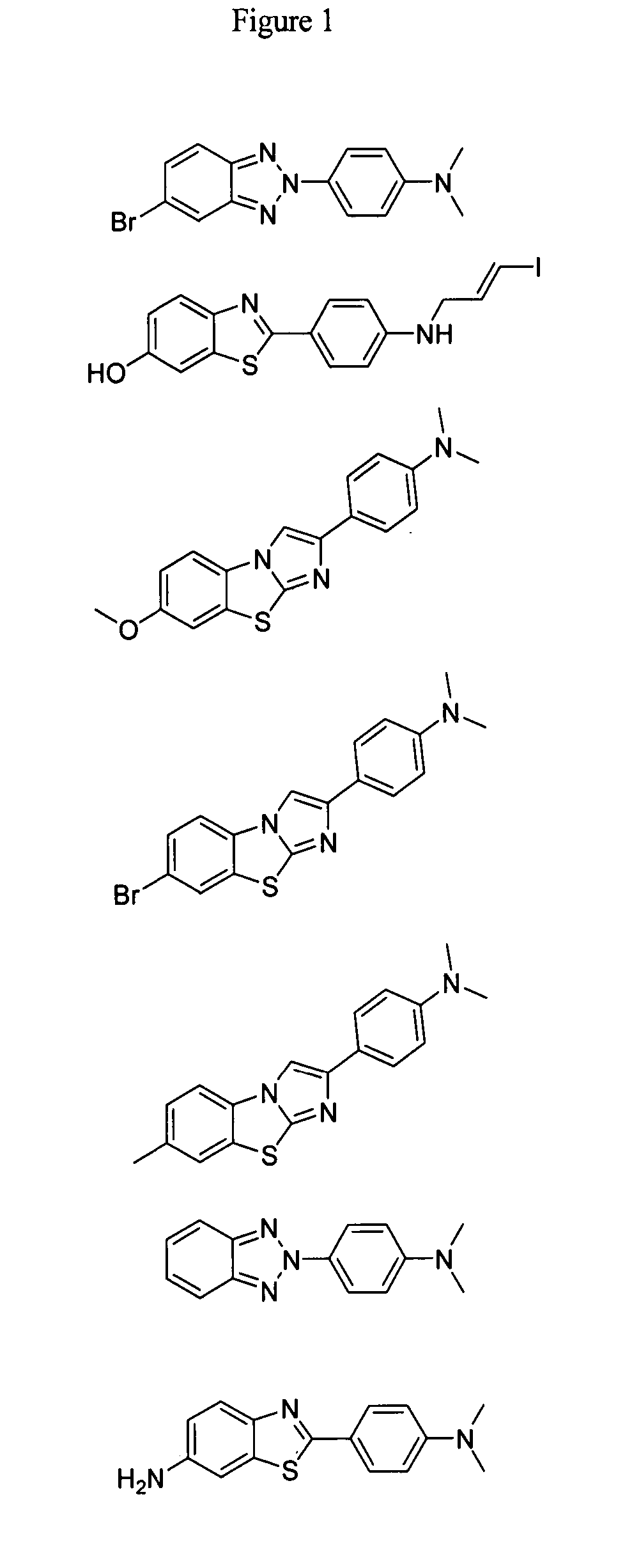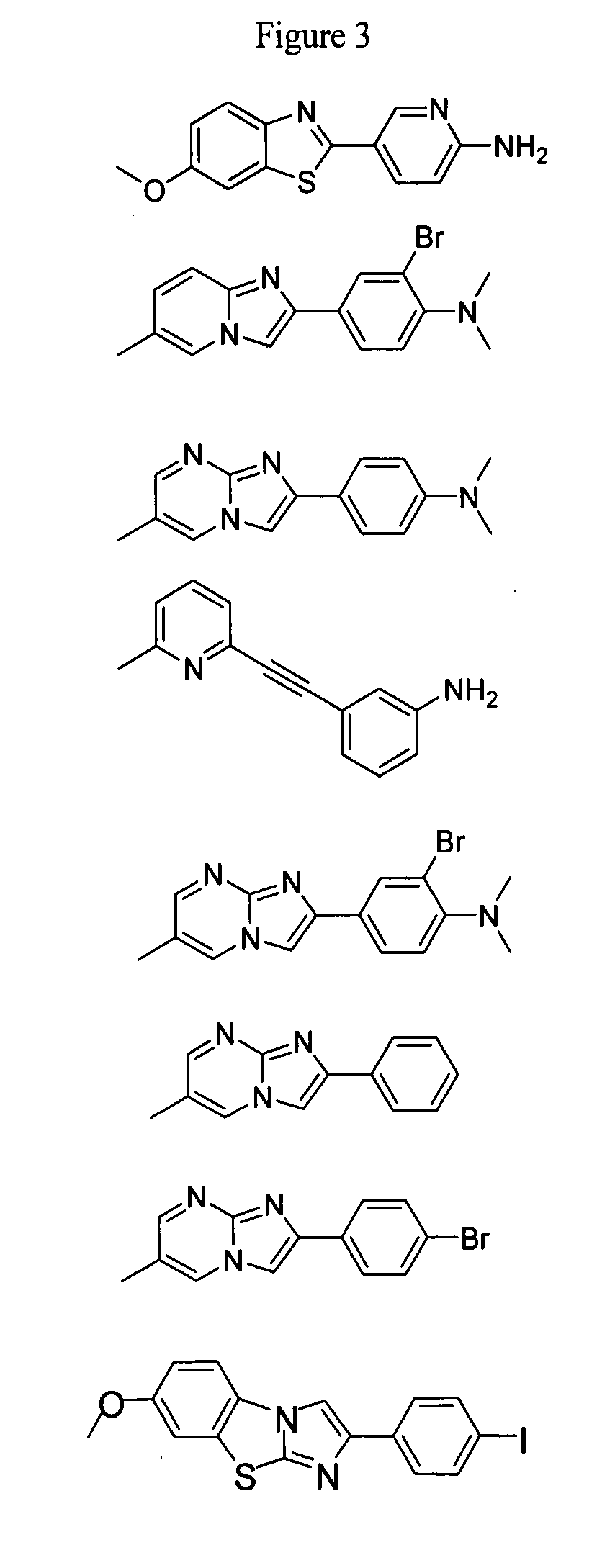Compounds and amyloid probes thereof for therapeutic and imaging uses
a technology of amyloid probes and compounds, applied in the direction of biocide, drug composition, therapy, etc., can solve the problems of significant morbidity and death, delay in assessment of neuritic plaque counts, and unknown time of onset, and achieve low toxicity and low toxicity
- Summary
- Abstract
- Description
- Claims
- Application Information
AI Technical Summary
Benefits of technology
Problems solved by technology
Method used
Image
Examples
example i
Series I Compounds of the Invention
[0148]
4′-dimethylaminoacetophenone (1)
[0149] In a mixture EtOH / HCl 37% 80 ml / 5 ml was dissolved 4′-aminoacetophenone (13.5 g, 0.1 mole), then formaldehyde 37% (15 ml) was added followed by PtO2 (150 mg). The resulting solution was hydrogenated at 50 PSI for 1 h, filtered through celite, evaporated and purified by flash chromatography (SiO2, hexane / AcOEt, 8 / 2) giving 1 as a white solid in 62% yield.
[0150] NMR 1H (CDCl3), δ=2.30 (s, 3H, CH3); 2.85 (s, 6H, 2CH3); 6.44 (d, 2H, J=9.0 Hz, 2CHAr); 7.67 (d, 2H, J=9.0 Hz, 2CHAr). NMR13C (CDCl3), δ=26.3 (1C, CH3); 40.4 (2C, 2CH3); 110.9 (2C, CHAr); 125.6 (1C, Cq), 130.9 (2C, CHAr); 153.7 (1C, Cq); 196.7 (1C, Cq).
2,2-dibromo-4′-dimethylaminoacetophenone (2)
[0151] In 20 ml of concentrated H2SO4 was dissolved 1 (3.8 g, 1 eq), then at 0° C. bromine (1.19 ml, 1 eq) was added dropwise and the resulting mixture was stirred at RT for 6 h before being poured into 200 ml of ice / H2O. The resulting precipitate was ...
example ii
Series II Compounds of the Invention
[0160]
2-(2-(4-dimethylaminophenyl)diazenyl)benzeneamine (8a)
[0161] o-Phenylenediamine (2 g, 1 eq), 4-dimethylaminonitrozoaniline (2.77 g, 1 eq) and NaOH (740 mg, 1 eq) were mixed neat and heated at 70° C. for 20 min with constant triturating. The resulting paste was extracted with toluene, concentrated in vacuum and purified by flash chromatography (SiO2, hexane / AcOEt, 8 / 2) giving 8a as a red solid in 43% yield.
[0162] NMR 1H (CDCl3), δ=2.89 (s, 6H, 2CH3); 5.44 (bs, 2H, NH2); 6.59-6.62 (m, 3H, 3CHA3); 6.67 (td, 1H, J=8.0, 1.2 Hz, CHAr); 7.02 (td, 1H, J=8.0, 1.2 Hz, CHAr); 7.64 (dd, 1H, J=8.0, 1.2 Hz, CHAr); 7.70 (d, 2H, J=9.2 Hz, CHAr). NMR 13C (CDCl3), δ=40.4 (2C, CH3); 111.7 (2C, CHAr); 116.8 (1C, CHAr); 117.5 (1C, CHAr); 125.6 (2C, CHAr); 126.1 (1C, CHAr); 130.7 (1C, CHAr); 137.8 (1C, Cq); 143.1 (1C, Cq); 143.9 (1C, Cq); 151.9 (1C, Cq).
1-(2-amino-4 and-5-bromophenyl)-2-(4-dimethylaminophenyl)diazene (8b)
[0163] 4-bromo-1,2-phenylenediamine (...
example iii
Series III Compounds of the Invention
[0214]
2-(3-methoxyphenyl)oxazol-4(5H)-one (16)
[0215] 2 g (1 eq) of 3-methoxybenzamide was mixed with 3.1 ml (2.7 eq) of chloroacethylchloride and the resulting mixture was heated at 110° C. for 1 h. After cooling, the resulting solid was recrystallized in CHCl3. The resulting solid was added to a suspension of NaH (489 mg, 1.1 eq) in DME at 0° C. After 30 min, the resulting mixture was refluxed for 5 h, cooled to RT and hydrolyzed, extracted with AcOEt, washed with NaCl salt and dried. The resulting solid was recrystallized in a mixture hexane / AcOEt giving 16 as a white solid in 26% yield.
[0216] NMR 1H (CDCl3), δ=3.85 (s, 3H, CH3); 4.74 (s, 2H, CH2); 7.22 (dd, 1H, J=8.0, 2.4 Hz, CHAr); 7.42 (t, 1 H, J=8.0 Hz, CHAr); 7.69 (s, 1 H, CHAr); 7.77 (d, 1 H, J=8.0 Hz, CHAr). NMR 13C (CDCl3), δ=55.9 (1C, CH3); 70.2 (1C, CH2); 114.4 (1C, CHAr); 122.6 (1C, CHAr); 122.7 (1C, CHAr); 127.9 (1C, Cq); 130.4 (1C, CHAr); 160.1 (1C, Cq); 188.1 (1C, Cq); 189.9 (1...
PUM
| Property | Measurement | Unit |
|---|---|---|
| equilibrium dissociation constant | aaaaa | aaaaa |
| dissociation constant | aaaaa | aaaaa |
| wavelength | aaaaa | aaaaa |
Abstract
Description
Claims
Application Information
 Login to View More
Login to View More - R&D
- Intellectual Property
- Life Sciences
- Materials
- Tech Scout
- Unparalleled Data Quality
- Higher Quality Content
- 60% Fewer Hallucinations
Browse by: Latest US Patents, China's latest patents, Technical Efficacy Thesaurus, Application Domain, Technology Topic, Popular Technical Reports.
© 2025 PatSnap. All rights reserved.Legal|Privacy policy|Modern Slavery Act Transparency Statement|Sitemap|About US| Contact US: help@patsnap.com



